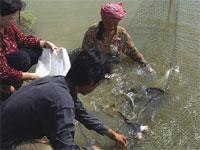Assessment of Mekong Capture Fisheries
 Capture
fisheries make by far the largest contribution to the Mekong's
fisheries. Evaluating the size and value of the capture fisheries
and recognising trends and patterns in the catch provide invaluable
indications of the both the health of the river and its fish
stocks. This is essential information in fisheries planning
and development.
Capture
fisheries make by far the largest contribution to the Mekong's
fisheries. Evaluating the size and value of the capture fisheries
and recognising trends and patterns in the catch provide invaluable
indications of the both the health of the river and its fish
stocks. This is essential information in fisheries planning
and development.
Many of the component's activities in 2004 were the continuation of work initiated during 2003. Results from some of these were presented at the Asian Fisheries Forum in Penang (Dec 2004) and at an FAO-sponsored nutrition workshop in Bangkok.
The main studies undertaken during the last year were:
Catch monitoring: Fishers' catches were monitored basinwide in a trial to establish systems for detecting trends in the fishery. Over 100 fishers, using a wide range of gears, were included. The study also provided valuable field experience for agency staff and facilitated agency-fisher dialogue. This work will continue as a long-term monitoring exercise using the fishers who provided the best quality data in each country.
Market monitoring: Markets were surveyed and individual traders monitored at key locations in each country. Markets are a key employer of women in fisheries. The results provided useful information on species composition and sizes and prices, as indicators of trends in the fishery, as well as useful information on methods and costs of establishing market-monitoring systems. Monitoring will continue at a reduced level.
Consumption study: Household consumption was monitored in each country with the objective of developing quantitative methods for such studies and comparing the results of interviews with actual consumption data. A report of this study is in draft and preliminary results were presented in workshops.
The component also supported several other studies in Cambodia and Viet Nam, including the following:
Dai fishery monitoring: 2004-5 was the 10th year of monitoring of the Tonle Sap Dai fishery, and the results showed the highest catch yet, a major recovery from the low catches of 2003-4. The catches were higher than predicted from flood levels, perhaps as a result of improved field enforcement of regulations to prevent fishing for fry in the closed season.
Fish larvae monitoring: Catches were higher than in 2003, reflecting the slightly above-average flood level.
Dai Trey Linh: This study in 2004 showed much higher catches than in 2003, reflecting a higher flood and probably also improved control of illegal fishing.
Yield per habitat: Several studies documenting the yields from rice fields and other habitats were completed. These provide important data for basin wide estimates of production.
Viet Nam Delta fisheries film: Shooting footage was completed for a film on the fisheries of the Mekong Delta in Viet Nam.
Viet Nam gear catalogue: Work began on documenting gears in all 12 provinces in the delta.
Inland fish as aquaculture feed: Counterparts surveyed the use of wild inland fish as a feed source in aquaculture of fish and crocodiles. The results will be presented at an international workshop in June 2006 in Viet Nam.
The component aims also to encourage the effective implementation of mitigation and management of development impacts. Following earlier workshops on fisheries EIA and mitigation in Lao, national workshops were held in 2004 in Cambodia and Viet Nam.
Counterparts began work on an ACIAR-sponsored project for the genetic analysis of a key Mekong species group, the small carps, Cirrhinus lobatus/ C. siamensis. Field sampling was carried out in the four countries and analyses of tissues began in Australia.
In each country, counterparts continued to receive various other kinds of training support, including report-writing, English, statistics and databases, and fisheries courses.
To ensure that information on the size and value of the fishery is incorporated in development planning requires effective reporting of results. Several reports were prepared during the year, and several more are in late stages of drafting. Work is continuing on cleaning databases and analysing and reporting data, and it is expected that the Viet Nam film and gear catalogue will be completed in 2005 or early 2006.
In 2005, we also expect to begin working on the valuation of
the fisheries; we will hire an international advisor to undertake
the project. This work will link to the core programmes of MRC,
because assessments of fisheries are required in all evaluations
of alternative development scenarios. Work will also continue
on environmental assessments, involving both programme advisors
and fisheries counterparts.
Choose a newsletter: